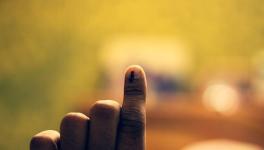Implementation of ‘One Nation, One Election’: Legal and Practical Challenges

Image credit: The Leaflet
There is speculation that the Union government may introduce a Bill on ‘one nation, one election’ (ONOE) in the special session of the Parliament set to be held from September 18 to 22.
On September 2, the Union government constituted a committee headed by the former President of India Ramnath Kovind to examine the feasibility of holding simultaneous elections to Lok Sabha and state assemblies under the banner of ONOE.
Currently, the general elections in the country to elect members of Lok Sabha and the elections to each state Assembly are conducted separately, on the expiry of terms of five years, unless Lok Sabha or a state Assembly is dissolved sooner.
Constitutional and practical challenges
ONOE faces certain constitutional and practical challenges.
The biggest challenge is how to align the tenure of Lok Sabha with that of legislative assemblies.
In order to institute ONOE, several state assemblies whose tenure of five years is not going to be complete by the time of the next Lok Sabha elections will require premature dissolution.
This may be in the teeth of Article 172, which provides: “Every legislative assembly of every state, unless sooner dissolved, shall continue for five years.”
A state Legislative Assembly cannot be dissolved before the completion of its term, except under a few specified circumstances.
First, a state Assembly can be dissolved by the governor in case of failure of law and order, or at the request of the chief minister of that state.
Second, a state Assembly can be dissolved if a motion of no confidence is passed against the ruling majority party or coalition.
Third, a state Assembly can be dissolved by imposing President’s rule in the state under Article 356.
However, Article 356 can be invoked only on the ground of failure of constitutional machinery in the state.
That is, if a state government is unable to work in accordance with the provisions of the Constitution, the governor may recommend the dissolution of the state Assembly to the President after which the Union government will take direct control of the administration of the state.
As per Article 83, the duration of Lok Sabha is five years, unless it is dissolved sooner.
These provisions of the Constitution will have to be amended before ONOE can be instituted.
Sections 14 and 15 of the Representation of the People Act, 1951 provide for holding general elections on the dissolution or end of a term of Lok Sabha, and elections to state legislative assemblies respectively.
If ONOE is implemented, these provisions will also have to be amended.
Issue of sustenance
Even if ONOE were to be implemented, it may not be sustainable.
Picture this. If simultaneous elections were somehow successfully conducted, but for one of the aforementioned reasons a state Assembly is dissolved.
Will there be President’s rule in that state till the next simultaneous elections, or will fresh Assembly elections be conducted midway?
If elections are indeed conducted midway, then how long will the tenure of the new state legislature be? Will it be for a full five year term or only until the date of the next simultaneous elections?
Similarly, after the conduct of simultaneous elections, if Lok Sabha is dissolved midway and general elections need to be conducted, does that mean all legislative assemblies and lawfully elected state governments will have to be dissolved as well?
In such a scenario, will there be President’s rule in the country till a new government is elected after the next simultaneous elections?
These are the few questions that need to be answered before the implementation of ONOE.
The concept of holding national, state and local elections together is not new. Till 1967, elections to state assemblies and Lok Sabha were in fact held simultaneously.
However, in 1968 and 1969, some legislative assemblies were dissolved prematurely followed by the dissolution of Lok Sabha in 1970.
This put the electoral schedules of state assemblies and Lok Sabha out of sync.
When holding simultaneous elections was not sustainable the first time around, how can anyone claim that doing so will be sustainable now?
Mohammad Anas is a practising advocate. He writes on current legal and political issues and is a defender of human rights. In his spare, time he likes to watch documentaries and non-fiction work. He also plays cricket and snooker. The views are personal.
Get the latest reports & analysis with people's perspective on Protests, movements & deep analytical videos, discussions of the current affairs in your Telegram app. Subscribe to NewsClick's Telegram channel & get Real-Time updates on stories, as they get published on our website.
























